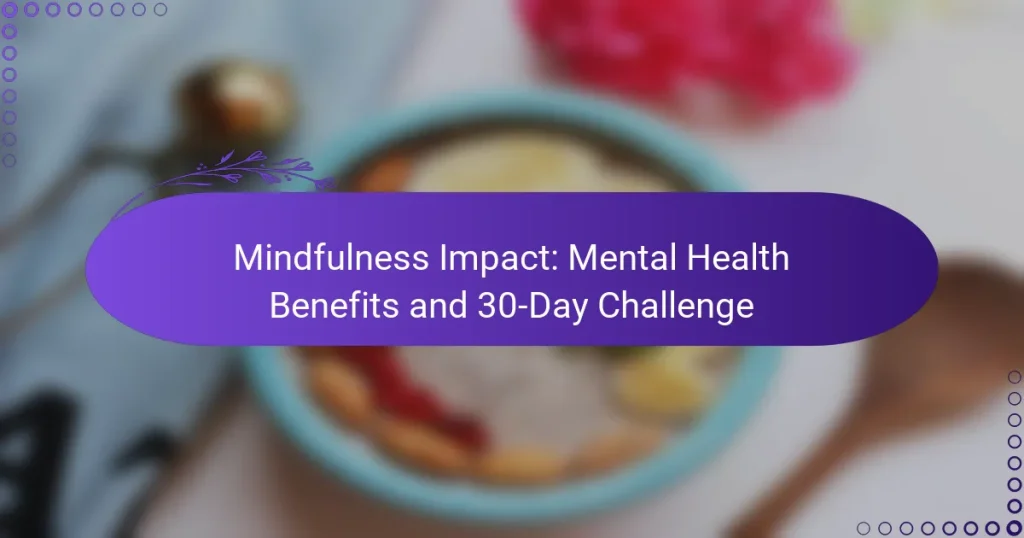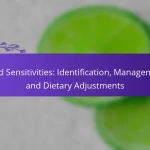Mindfulness is a powerful tool for enhancing mental health, as it encourages greater awareness of thoughts and emotions, ultimately fostering emotional resilience. By participating in a 30-day mindfulness challenge, individuals can experience significant benefits, including reduced stress and improved overall well-being, while developing a deeper connection to themselves and their environment.

How does mindfulness improve mental health?
Mindfulness enhances mental health by fostering a greater awareness of thoughts and emotions, leading to improved emotional resilience. Practicing mindfulness can help individuals manage their mental states more effectively, reducing negative feelings and promoting a sense of calm.
Reduces anxiety and stress
Mindfulness practices, such as meditation and deep breathing, can significantly lower anxiety and stress levels. By focusing on the present moment, individuals can break the cycle of worrying about the future or ruminating on the past, which often fuels anxiety.
To incorporate mindfulness for stress reduction, try dedicating a few minutes each day to mindful breathing or guided meditation. Even short sessions can lead to noticeable improvements in stress management.
Enhances emotional regulation
Mindfulness helps individuals recognize their emotional responses, allowing for better control over reactions. By observing feelings without judgment, people can respond to situations more thoughtfully rather than impulsively.
Practicing mindfulness techniques, such as journaling or body scans, can enhance emotional awareness. This awareness can lead to healthier coping strategies and improved relationships with others.
Improves focus and concentration
Engaging in mindfulness can sharpen focus and concentration by training the brain to stay present. Regular practice can lead to improved attention spans and the ability to concentrate on tasks without distraction.
To boost focus, consider setting aside specific times for mindfulness exercises, such as mindful walking or focused breathing. These practices can help clear mental clutter and enhance productivity.
Promotes overall well-being
Mindfulness contributes to overall well-being by fostering a positive mindset and enhancing life satisfaction. It encourages individuals to appreciate the present, which can lead to a more fulfilling life experience.
Incorporating mindfulness into daily routines, such as mindful eating or gratitude practices, can promote a sense of balance and well-being. Aim for consistency, as regular practice is key to experiencing lasting benefits.

What are the key benefits of a 30-day mindfulness challenge?
A 30-day mindfulness challenge can significantly enhance mental health by promoting emotional balance, reducing stress, and improving overall well-being. Engaging in daily mindfulness practices fosters a deeper connection to oneself and the surrounding environment, leading to lasting positive changes.
Establishes a daily practice
Committing to a 30-day mindfulness challenge helps establish a consistent daily practice. By dedicating just a few minutes each day to mindfulness activities, such as meditation or deep breathing, individuals can create a routine that becomes a natural part of their day.
To effectively build this habit, consider setting a specific time each day, such as in the morning or before bed. Using reminders or mindfulness apps can also support adherence to the practice.
Increases self-awareness
Participating in a mindfulness challenge enhances self-awareness by encouraging individuals to observe their thoughts and feelings without judgment. This heightened awareness can lead to better understanding of personal triggers and emotional responses.
To cultivate self-awareness, try journaling after each mindfulness session. Reflecting on your experiences can help identify patterns in your thoughts and behaviors, making it easier to address areas for personal growth.
Builds resilience
A 30-day mindfulness challenge can strengthen emotional resilience by teaching individuals how to manage stress and adversity more effectively. Mindfulness practices promote a calm and centered mindset, enabling better responses to challenging situations.
To build resilience, focus on developing a positive mindset through gratitude exercises during your mindfulness sessions. Acknowledging what you are thankful for can shift your perspective and enhance your ability to cope with difficulties.
Enhances relationships
Mindfulness can improve relationships by fostering better communication and empathy. As individuals become more aware of their own emotions, they can better understand and respond to the feelings of others.
To enhance relationships, practice active listening during conversations. This means fully engaging with the speaker, acknowledging their feelings, and responding thoughtfully, which can lead to deeper connections and mutual understanding.

How to start a 30-day mindfulness challenge?
Starting a 30-day mindfulness challenge involves committing to daily mindfulness practices that enhance your mental well-being. By setting specific goals and following a structured approach, you can effectively integrate mindfulness into your routine.
Set clear goals
Establishing clear goals is essential for a successful mindfulness challenge. Consider what you want to achieve, whether it’s reducing stress, improving focus, or enhancing emotional regulation. Write down your goals to keep them visible and motivate yourself throughout the month.
Make your goals specific and measurable. For example, instead of saying “I want to be more mindful,” specify “I will practice mindfulness for 10 minutes each day.” This clarity helps you stay on track and assess your progress.
Choose a mindfulness technique
Selecting a mindfulness technique that resonates with you is crucial. Popular options include meditation, deep breathing exercises, body scans, or mindful walking. Experiment with different methods to find what feels most comfortable and effective for you.
Consider using guided apps or online resources to help you learn and practice these techniques. Many apps offer structured programs that can guide you through your 30-day challenge, making it easier to stay committed.
Create a daily schedule
Creating a daily schedule helps you incorporate mindfulness into your routine. Choose a consistent time each day, whether it’s morning, lunch break, or evening, to practice mindfulness. Consistency builds habit, making it easier to stick to your challenge.
Start with shorter sessions, around 5 to 10 minutes, and gradually increase the duration as you become more comfortable. Block out this time in your calendar to treat it as an important appointment.
Track your progress
Tracking your progress is vital for maintaining motivation during your 30-day mindfulness challenge. Keep a journal or use an app to record your daily practice, noting how you feel before and after each session. This reflection can highlight the benefits of mindfulness over time.
Consider setting up a simple checklist to mark off each day you complete your practice. This visual representation of your commitment can encourage you to continue and help you recognize patterns in your mindfulness journey.

What mindfulness techniques are effective?
Effective mindfulness techniques include guided meditation, body scans, mindful breathing, and walking meditation. Each method offers unique benefits and can be tailored to individual preferences and lifestyles.
Guided meditation
Guided meditation involves listening to a narrator or teacher who leads you through a meditation session. This technique can help beginners by providing structure and direction, making it easier to focus and relax.
To practice guided meditation, find a quiet space, sit comfortably, and use an app or online resource to follow along. Sessions typically last from 5 to 30 minutes, allowing flexibility based on your schedule.
Body scan
The body scan technique encourages awareness of physical sensations throughout the body. By mentally scanning from head to toe, practitioners can identify areas of tension and promote relaxation.
To perform a body scan, lie down comfortably and focus on each body part sequentially, noticing any sensations without judgment. This practice can take anywhere from 10 to 30 minutes and is particularly effective for reducing stress and anxiety.
Mindful breathing
Mindful breathing centers on paying attention to your breath as it flows in and out. This technique helps anchor your thoughts and can be practiced anywhere, making it highly accessible.
To practice mindful breathing, sit or stand comfortably, close your eyes, and focus on your breath. Aim for 5 to 10 minutes of uninterrupted attention, gently returning your focus to your breath whenever your mind wanders.
Walking meditation
Walking meditation combines movement with mindfulness, allowing you to focus on the sensations of walking. This technique is especially beneficial for those who find it challenging to sit still during meditation.
To practice walking meditation, choose a quiet space where you can walk slowly and deliberately. Pay attention to each step, the feeling of your feet on the ground, and your surroundings. Sessions can last from 10 to 30 minutes, depending on your comfort level.

What resources are available for mindfulness practice?
Numerous resources exist to support mindfulness practice, catering to various preferences and learning styles. These include mobile applications, books, and online courses that provide structured guidance and techniques for cultivating mindfulness.
Apps like Headspace and Calm
Mobile applications such as Headspace and Calm offer guided meditations and mindfulness exercises designed for users of all levels. These apps typically feature a variety of sessions ranging from a few minutes to over an hour, allowing users to choose based on their available time and experience.
Headspace focuses on bite-sized lessons and themed courses, while Calm emphasizes soothing sounds and sleep aids. Both apps often include free trials, enabling users to explore their offerings before committing to a subscription.
Books such as “The Miracle of Mindfulness”
Books like “The Miracle of Mindfulness” by Thich Nhat Hanh provide in-depth insights into mindfulness principles and practices. These texts often include practical exercises and anecdotes that help readers integrate mindfulness into their daily lives.
Reading such books can serve as a foundational step for beginners, offering a comprehensive understanding of mindfulness concepts. Many readers find it beneficial to keep a journal alongside their reading to reflect on their experiences and insights.
Online courses and workshops
Online courses and workshops offer structured learning experiences for those seeking to deepen their mindfulness practice. Platforms like Coursera and Udemy provide a range of options, from introductory courses to advanced workshops led by experienced instructors.
These courses often include video lectures, guided meditations, and community discussions, allowing participants to engage with others on a similar journey. When selecting a course, consider factors such as duration, cost, and the instructor’s credentials to ensure it meets your needs.

